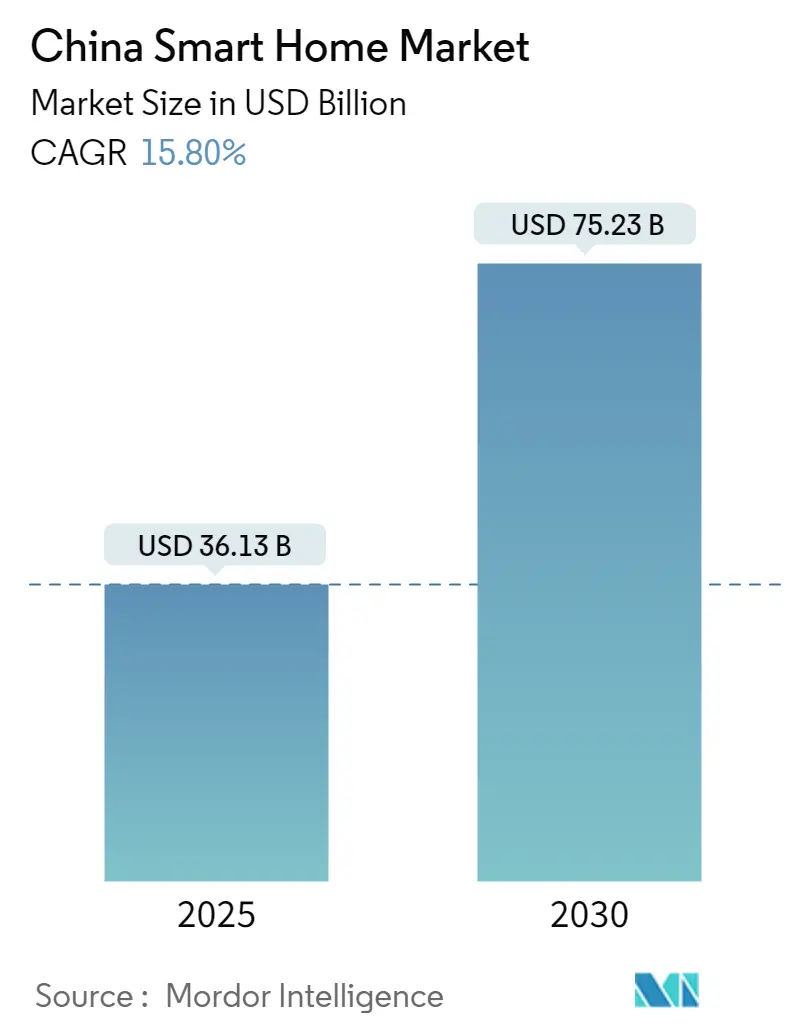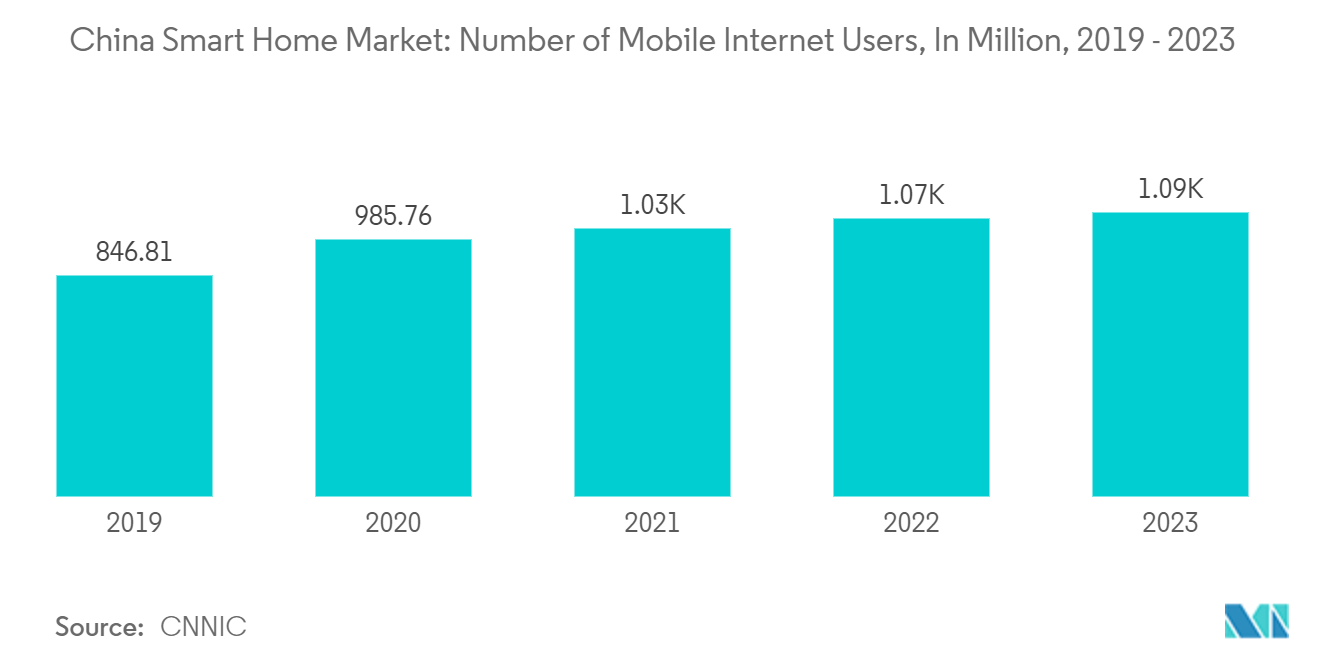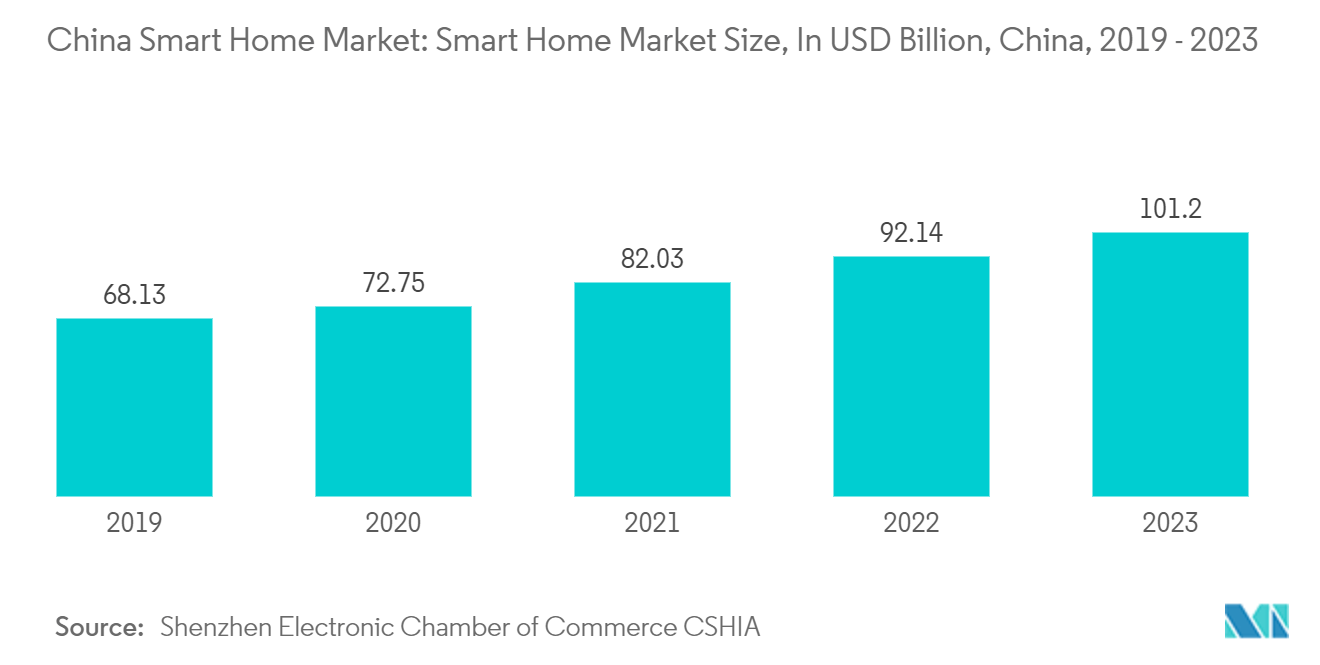China Smart Home Market Size and Share

China Smart Home Market Analysis by Mordor Intelligence
The China Smart Home Market size is estimated at USD 36.13 billion in 2025, and is expected to reach USD 75.23 billion by 2030, at a CAGR of 15.8% during the forecast period (2025-2030).
- Chinese consumers are increasingly familiar with the term 'smart home' as many smart devices flood the market, and brands emphasize 'smartness' in their home appliances. Leveraging public-private partnerships and targeted technological innovations, China has successfully rolled out smart city infrastructure in many major metropolises, extending its reach into the residential sector.
- Shifting from an export-driven to a consumption-centric economy, China is pivoting toward energy efficiency while not facing notably high energy costs. The government, recognizing the significance of energy and water conservation, is actively promoting smart home technologies that optimize resource usage.
- Advancements in sensor technology have led to innovations like sensor-embedded insulation and 'smart mirrors' capable of monitoring skin conditions. Beyond the novelty, the ability of these new sensors to process data locally is poised to hasten the widespread adoption of smart home technologies.
- While Western smart cities often adopt a grassroots approach, China's strategy is predominantly top-down, with the central government leading. A notable example is the joint issuance of guidelines at the beginning of 2022 by 16 government departments, including the Ministry of Housing and Urban-Rural Development and the Ministry of Public Security. These guidelines laid out policies, systems, and standards for digital homes.
- China's tech behemoths, including Alibaba, Tencent, Didi Chuxing, Baidu, and Huawei, are pivotal in the nation's drive to modernize its city infrastructures. Their concerted efforts align with China's overarching ambition of smart city development, further bolstering the prospects of the smart home market in China.
- Furthermore, in June 2023, Xiaomi announced a new MIJIA smart home appliance in the Chinese market. The new MIJIA Intelligent Multipurpose Oven with a steamer is built to offer multiple cooking methods in a single package.
China Smart Home Market Trends and Insights
China's Smart Home Market Surges on the Back of Digitization
- Digitization in China is catalyzing the adoption of cutting-edge technologies, enabling businesses to expand their reach, enhance operational efficiency, and craft innovative products. The widespread use of Alipay and WeChat Pay exemplifies this trend. While consumers increasingly embrace a digital lifestyle, the pace of technological adoption varies.
- According to the Chinese Academy of Cyberspace Studies, in 2022, China's digital economy had surged to CNY 50.2 trillion (approximately USD 6.99 trillion) from CNY 11 trillion in 2012. As of June 2023, China boasted around 1.08 billion internet users, nearly doubling the figure from 2012. Concurrently, internet penetration soared from 42.1% to 76.4%.
- Moreover, GSMA highlights that over 800 million mobile connections in China are now 5G-enabled. Projections suggest that by the end of 2024, 5G connections will surpass 50%, solidifying its position as the primary mobile technology in China, with total connections expected to exceed 1 billion.
- According to CNNIC, by December 2023, approximately 1.09 billion people in China accessed the internet via a mobile device, up from around 1.08 billion in the first half of 2023.
- Furthermore, during and after the COVID-19 pandemic, the internet and digital devices played pivotal roles, facilitating everything from medical consultations to remote work. Consequently, as digitization deepens, the smart home market in China is not just growing; it is poised for sustained expansion in the coming years.

Comfort and Lighting to Witness Significant Growth
- Many property owners embrace sustainability by transitioning to LED lighting in their residential communities. With extensive lighting networks that operate round the clock, these properties are finding significant energy savings by switching to smart LED solutions. Consequently, renters and homeowners are following suit, opting for a diverse range of smart LED options for their interior lighting.
- The journey of smart lighting has been remarkable. The advent of LED technology marked a pivotal moment, revolutionizing the lighting landscape. LEDs, with their enhanced energy efficiency, durability, and extended lifespan, outshine traditional bulbs. A key trend in smart homes is the surge of intelligent lighting and home automation. Consumers now seek lighting solutions that can be controlled remotely via smartphones, voice assistants, or integrated smart home systems, offering convenience and installation flexibility.
- Energy efficiency has become a focal point in China. In the mid-1990s, the country grappled with a severe power shortage driven by its burgeoning population, expanding economy, and rising living standards. The pressure on the Chinese government intensified as the need for new power plants clashed with limited infrastructure funding. This backdrop spurred a nationwide push for energy efficiency.
- China, a well-known LED lighting manufacturer, leverages its deep-rooted expertise in electronics, optics, and high-tech industries. Chinese policymakers are revisiting the national minimum energy performance standards (MEPS) for LED products, aiming to broaden the regulatory coverage and elevate the nation's lighting standards.
- As the demand for LED lighting surges, especially in urban residential settings, the smart home industry is witnessing a parallel rise in its adoption.

Competitive Landscape
The Chinese smart home market is fragmented. The market is highly concentrated due to the presence of various small and large players. All the major players account for a significant market share and focus on expanding their consumer base. Some of the critical players in the market are Schneider Electric SE, Emerson Electric Corporation, ABB Ltd, Honewell International Inc., and Siemens AG. Companies are increasing their market share by forming multiple collaborations, partnerships, and acquisitions and investing in introducing new products to earn a competitive edge during the forecast period.
- May 2024: ABB signed an agreement to acquire Siemens' Wiring Accessories business in China. This will broaden ABB’s market reach and complement its regional customer offering within smart buildings. The offering ABB is acquiring includes wiring accessories, smart home systems, smart door locks, and further peripheral home automation products, which will continue under the Siemens brand under terms of a licensing agreement.
- August 2023: Samsung Electronics and LG Electronics collaborated to create a Smart Home to advance smart living. The collaboration includes combining the smart home platforms of both companies in the cloud to enhance connectivity between devices. Samsung Electronics and LG Electronics collaborated to connect their appliances seamlessly. This significant measure marks the first commercial implementation of the HCA (Home Connectivity Alliance) standard 1.0.
China Smart Home Industry Leaders
-
Schneider Electric SE
-
Emerson Electric Co.
-
ABB Ltd.
-
Honeywell International Inc.
-
Siemens AG
- *Disclaimer: Major Players sorted in no particular order
.webp)
Recent Industry Developments
- February 2024: Microsoft disclosed a new patent indicating that the company is developing a self-sufficient smart home system for Windows devices. This system, known as multi-device cross-experience, will be driven by AI. It allows connected devices to interact with each other through advertising without the need for user input. Devices within the system will continuously communicate with each other and perform actions when certain conditions are fulfilled.
- September 2023: Toshiba HVAC, a part of Carrier Global Corporation, announced the launch of its new Digital Inverter (DI) series in mainland China, which is a light commercial ductless split air-conditioning systems that is easy to install and provides a range of energy-efficient, intelligent offerings. The new DI series offers various benefits such as energy efficiency, easy installation, broad lineup, comfort, easy cleaning process, and intelligence.
China Smart Home Market Report Scope
A smart home refers to a set of integrated and networked devices that automate different functions within a home and can communicate both with each other and with a centralized control interface. The prominent purpose of this type of system is to enhance comfort, safety, energy efficiency, and management of household resources.
The Chinese smart home market is segmented by product type (comfort and lighting, control and connectivity, energy management, home entertainment, security, smart appliances, and HVAC control) and technology (Wi-Fi, Bluetooth, and other technologies). The report offers the market sizes and forecasts for all the above segments in value (USD).
| Comfort and Lighting |
| Control and Connectivity |
| Energy Management |
| Home Entertainment |
| Security |
| Smart Appliances |
| HVAC Control |
| Wi-Fi |
| Bluetooth |
| Other Technologies |
| By Product Type | Comfort and Lighting |
| Control and Connectivity | |
| Energy Management | |
| Home Entertainment | |
| Security | |
| Smart Appliances | |
| HVAC Control | |
| By Technology | Wi-Fi |
| Bluetooth | |
| Other Technologies |
Key Questions Answered in the Report
How big is the China Smart Home Market?
The China Smart Home Market size is expected to reach USD 36.13 billion in 2025 and grow at a CAGR of 15.80% to reach USD 75.23 billion by 2030.
What is the current China Smart Home Market size?
In 2025, the China Smart Home Market size is expected to reach USD 36.13 billion.
Who are the key players in China Smart Home Market?
Schneider Electric SE, Emerson Electric Co., ABB Ltd., Honeywell International Inc. and Siemens AG are the major companies operating in the China Smart Home Market.
What years does this China Smart Home Market cover, and what was the market size in 2024?
In 2024, the China Smart Home Market size was estimated at USD 30.42 billion. The report covers the China Smart Home Market historical market size for years: 2019, 2020, 2021, 2022, 2023 and 2024. The report also forecasts the China Smart Home Market size for years: 2025, 2026, 2027, 2028, 2029 and 2030.
Page last updated on:
China Smart Home Market Report
Statistics for the 2025 China Smart Home market share, size and revenue growth rate, created by Mordor Intelligence™ Industry Reports. China Smart Home analysis includes a market forecast outlook for 2025 to 2030 and historical overview. Get a sample of this industry analysis as a free report PDF download.



